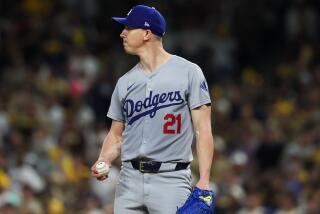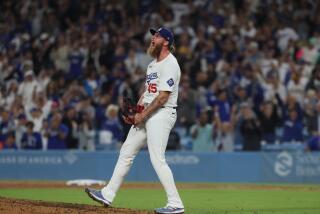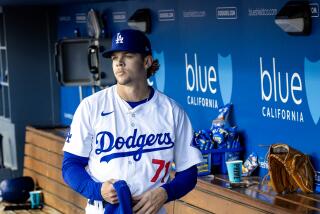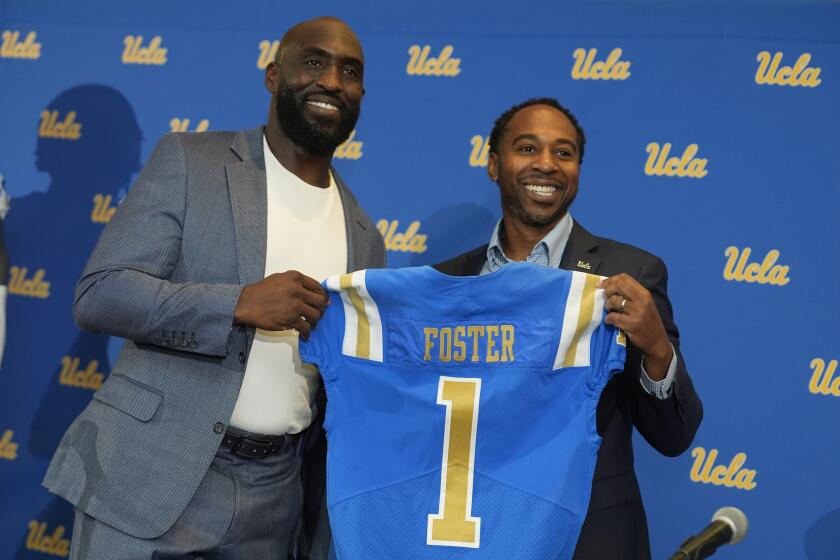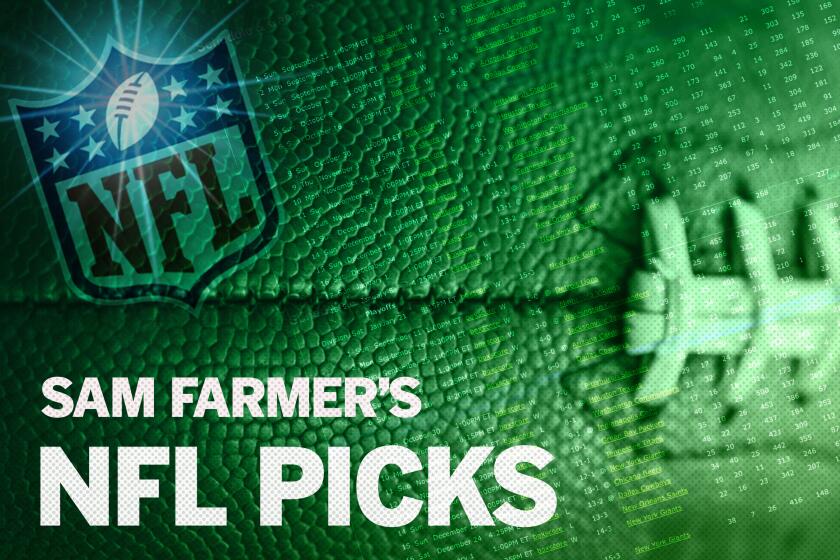Left-handed pitching trio is all right for Dodgers
The world is stacked against them, an unspoken prejudice against the poor left-hander.
It’s not a good thing to have two left feet, to receive a left-handed compliment. Go down the left-hand path and you’re into black magic, or maybe just reality shows. Power tools, guitars, cameras, rifles — all designed for a right-handed world.
Then there’s baseball.
In baseball, good left-handed pitchers are prized possessions. They can turn strong hitters into weak-kneed corkscrews. Get into heads and seize control.
And no team, anywhere, has three left-handed starters going right now like the Dodgers.
Entering Wednesday’s games, Clayton Kershaw, Ted Lilly and Chris Capuano combined had a dazzling 15-2 record with a 1.99 earned-run average. And even after Lilly’s meltdown that night — eight earned runs, nine hits and five walks in 31/3 innings — the ERA is still only 2.38.
If they were to somehow keep that up, they’d only go down as the greatest trio of left-handed starters in one rotation ever.
With the Arizona Diamondbacks sending left-hander Patrick Corbin down Tuesday, the Dodgers became the only team in baseball currently with three left-handed starters.
“I don’t mind at all, particularly when they’re pitching like this,” Dodgers Manager Don Mattingly said. “I don’t want to have lefties just to have lefties.
“But guys have trouble with lefties. They just don’t see them as much. It’s just a different look.”
Not so different as to be unique. This is hardly the first time the Dodgers have successfully used a trio of left-handed starters. In 1965, their four-man rotation included Sandy Koufax (26-8, 2.04 ERA), Claude Osteen (15-15, 2.79) and Johnny Podres (7-6, 3.43) around No. 2 starter Don Drysdale (23-12, 2.77).
In 1973, they had Osteen (16-11, 3.31), Tommy John (16-7, 3.10) and Al Downing (9-9, 2.98), though the ace was Don Sutton. And in 1985 they used Fernando Valenzuela (17-10, 2.45), Jerry Reuss (14-10, 2.92) and current pitching coach Rick Honeycutt (8-12, 3.42).
“It’s pretty unusual to have three,” Honeycutt said. “These guys have all had success. This is my seventh year [with the Dodgers], and this is by far the most experienced five guys we’ve had.”
The ace of the staff is clearly Kershaw (4-1, 1.90), the National League’s reigning Cy Young Award winner. But Capuano is 6-1 with a 2.25 ERA and Lilly, who had not given up more than three earned runs in 19 consecutive starts before Wednesday, is 5-1 with a 3.14 ERA.
“If you looked up and had never seen our team before, you might say one of those guys” — Lilly or Capuano — “is our top guy by their presence on the mound and way they’re out there competing,” said outfielder Andre Ethier.
It doesn’t hurt the Dodgers’ cause that the three have different styles. Kershaw can fire the ball, while Lilly is the master craftsman with an array of looks, and Capuano is somewhere in between, leaning more toward Lilly.
“You get lefties that give you a lot different looks with different pitches; guys don’t know what to do with them,” Mattingly said.
The Dodgers are careful not to have Lilly and Capuano follow each other in the order, keeping the rotation from back-to-back lefties no longer considered power pitchers.
Joined by right-handed starters Chad Billingsley and Aaron Harang, the Dodgers’ rotation has an ERA of 3.06, the second-lowest in baseball.
Capuano thinks that three lefties’ leading the charge is coincidental — and he was Phi Beta Kappa at Duke.
“I don’t think there’s anything there,” Capuano said. “… Whether you’re left- or right-handed, if you make your pitches, you’re going to do well. It doesn’t matter what arm you’re throwing with.”
Lilly was part of another top left-handed trio in 2003 with the Oakland Athletics, joining Mark Mulder and Barry Zito, and the 1997 Seattle Mariners got outstanding seasons from lefties Randy Johnson, Jeff Fassero and Jamie Moyer, who combined to win 53 games.
Yet the first three-headed left-handed rotation that comes to Mattingly’s mind is closer to home — the 1991 Angels of Mark Langston, Chuck Finley and Jim Abbott, who combined to win 55 games.
“That’s the best I remember,” Mattingly said. “I know when I was a hitter, I preferred rotations of all righties. I didn’t really like the lefties as much.”
It’s estimated that only 10% of the population is purely left-handed. It has to be a different look. Through Tuesday, major league teams were 466-435 against right-handed starters but only 178-225 against left-handed starters.
The right hand of God, indeed.
Logic indicates the advantage should be the other way around. Since lefties have an advantage against left-handed hitters, and baseball is made up more of right-handed hitters, it could be argued they should struggle more than right-handers.
“I think most left-handed starters generally have themselves trained to get right-handed hitters out because predominantly that’s what you see,” Lilly said. “Basically, if you can’t get a right-handed hitter out, you won’t be a starting pitcher.”
Any other way would be so gauche. Which is French for left.
Sorry, did that come out of left field?
More to Read
Go beyond the scoreboard
Get the latest on L.A.'s teams in the daily Sports Report newsletter.
You may occasionally receive promotional content from the Los Angeles Times.
